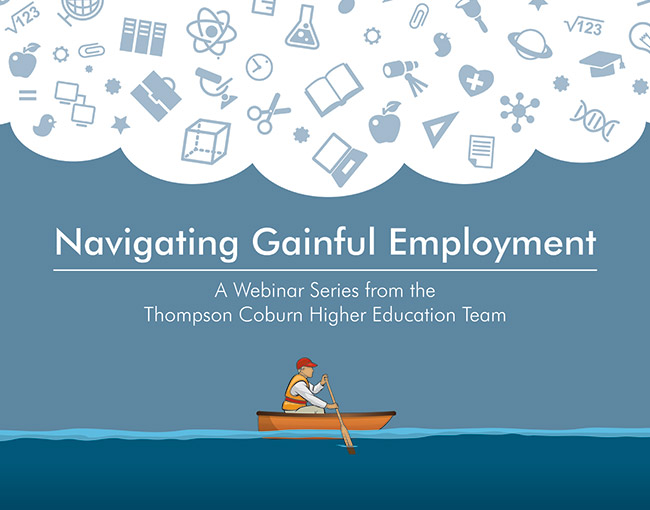
Gainful Employment Webinar Series
Gainful Employment - How to Project Reliable Debt-to-Earnings Rates
In late 2014, we hosted a webinar on this topic, followed shortly thereafter by the publication of our desk guide, How to Project Gainful Employment Rates. In this first webinar, we provide step-by-step instructions for projecting debt-to-earnings rates, incorporating the guidance and information gleaned from the Department over the last year.
CLE
The live presentation of this program was approved for 1.0 hour general CLE credit in California and Illinois, and 1.2 general CLE credit in Missouri. CLE credit is no longer available for this recording.
Presenter:
Aaron Lacey
Originally Presented:
February 11, 2016
Gainful Employment – Strategies for Improving Debt-to-Earnings Rates
This webinar again focuses on the Department’s debt-to-earnings metrics and, more specifically, on strategies for potentially improving debt-to-earnings rate performance in years to come. While there is no single solution for most institutions, a combination of sound strategies may return a troubled program to long-term eligibility, or ensure that a strong program continues to perform well.
CLE
The live presentation of this program was approved for 1.0 hour general CLE credit in California and Illinois, and 1.2 general CLE credit in Missouri. CLE credit is no longer available for this recording.
Presenter:
Aaron Lacey
Originally Presented:
February 18, 2016
Gainful Employment – Completer List Challenges
The third webinar in our series examines the three ways schools can challenge the debt and earnings data the Department will use to calculate each GE program’s D/E rates. We discuss the first round of completer challenges (occurring in early 2016), as well as the loan debt and annual earnings challenges that will be available later this year (occurring in mid to late 2016).
CLE
The live presentation of this program was approved for 1.0 hour general CLE credit in California and Illinois, and 1.2 general CLE credit in Missouri. CLE credit is no longer available for this recording.
Presenter:
Aaron Lacey
Originally Presented:
February 25, 2016
Gainful Employment – Preparing for and Managing Required Student Warnings
For any program with failing debt-to-earning rates, institutions will have to begin providing prospective and current students with firm student warnings. The content of these warnings, and the requirements surrounding their distribution, may significantly disrupt the enrollment process. This webinar reviews in detail the requirements relating to the student warnings, and also discusses strategies for managing their impact.
CLE
The live presentation of this program was approved for 1.0 hour general CLE credit in California and Illinois, and 1.2 general CLE credit in Missouri. CLE credit is no longer available for this recording.
Presenter:
Aaron Lacey
Originally Presented:
March 3, 2016
Gainful Employment – Managing and Challenging the New GE Disclosures
In our final webinar, we revisit the GE disclosure requirements presently in effect, then segue into a discussion of the new information that institutions will be required to disclose beginning January 2017 (e.g., pCDR rates). We also discuss the opportunities that will be available to institutions to challenge this data.
CLE
The live presentation of this program was approved for 1.0 hour general CLE credit in California and Illinois, and 1.2 general CLE credit in Missouri. CLE credit is no longer available for this recording.
Presenter:
Aaron Lacey
Originally Presented:
March 10, 2016
